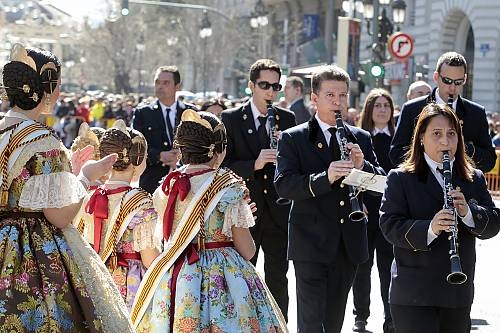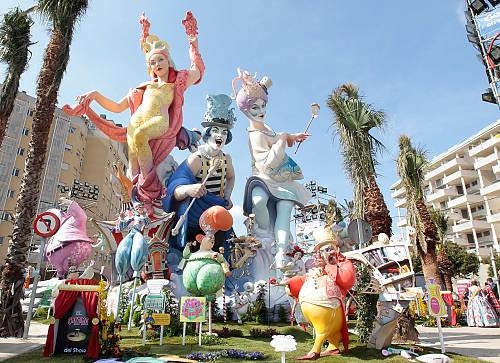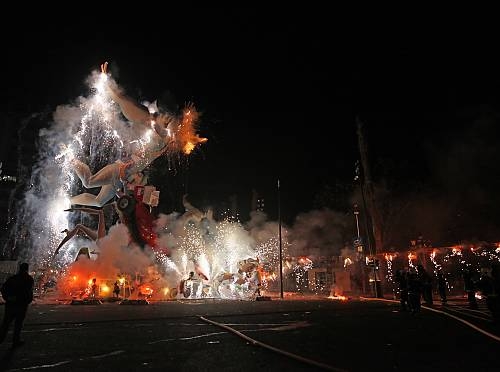Long live to the Fallas
©Holbox/ShutterstockUsually held from March 1st to the 19th, the Fallas Festival in Valencia is a widely popular annual cultural event which preserves local traditions and ensures their transmission for future generations. During the celebration, which symbolizes the coming of spring and the rejuvenation of community social activity, marching bands parade the streets, food is served outdoors, and firework displays are held. The main feature of the Fallas festival however is the giant falla, an ephemeral monument made up of ninots (caricature figures) created by local artists and craftspeople which is erected in the town square and set alight to mark the end of the festivities.
Las Fallas plays an important role in preserving local links to the exchanges in textiles which took place along the historic Silk Roads with the festivity accompanied by highly decorative traditional garments worn by both men and women and featuring silk embroidery and jewellery. Valencia was historically an important silk city and hub which connected Western Europe to the Silk Roads. As early as the 14th century, technological innovation in silk production reached Valencia from Genoa and the city became a major silk thread exporter to northern Italy. Valencia’s growing silk industry gave rise to its famous silk producing neighbourhood of Velluters and by the 16th century Valencia was the most important centre of silk fibre production in Spain. These links to the Silk Roads brought with them a vast exchange of other products reaching Valencia such as porcelain and tea, and with mercantile activity came an influx of scientists, travellers, and diplomats in a cultural exchange which greatly enriched the city. Today the cities rich silk legacy remains clearly evident, particularly in the city’s architecture.
The festival is particularly important for the community of Valencia as it generates creativity, maintains traditional artisan techniques, and contributes to forging and preserving cultural identity and social cohesion. “Las Fallas”, the symbolic sculptural monuments which line the streets during the festivities, are the bright and colourful centre pieces of the ritual. However, they are just one end result of a vast creative cycle that safeguards a network of cultural practices and sociability which is woven into the urban fabric of Valencia. The annual festival is also an important component of the local economy particularly within the realms of crafts, textile production, goldsmith activities, pyrotechnics, and music. An estimated 150,000 of the nearly 800,000 inhabitants of the city participate in Las Fallas in some way. Throughout the region 90 municipalities participate in the festival and several hundreds of monuments are created to burn. In Valencia city alone, around 800 works of art are created each year many of them several metres high.
Furthermore, in combining both silk and gunpowder, the Fallas are illustrative of the fascinating legacy of the Silk Roads which is still very much alive in the Western Mediterranean and beyond. In Valencia, the festivities also represent a cultural space of symbiosis in which music is combined with visual aesthetics and bands fill the streets with joyous melodies and lyrics to accompany the bright lights, colours, and designs of the Fallas monuments. In light of its significance for the local population Fiesta de Las Fallas was inscribed onto the UNESCO Representative List of the Intangible Cultural Heritage of Humanity in 2016. This nomination recognised the importance of the transmission of the know-how associated with Las Fallas within communities via the construction of ninots and through the production of traditional clothing. It also highlighted the ways in which the Fallas festivity provides a strong basis for collective creativity, safeguards traditional arts and crafts, provides a source of community pride, and contributes to enhancing social cohesion.
However, due to the COVID-19 pandemic the celebration was cancelled in 2020 and again in 2021. Currently several hundred of the statues and monuments which were constructed in the hopes of this year’s festival taking place are currently housed in warehouses with nowhere to go. This has eroded the continuity of the festival and placed all those participating in the preparation of the many elements of the event under threat. As the knowledge and craft skills for Las Fallas are passed down through generations the break in the continuity of the festivities poses a considerable threat to the survival of the important knowledges and skills associated with this vibrant element of the intangible cultural heritage of Valencia and of the wider Silk Roads more generally. As with many industries, the pandemic has also greatly threatened the silk industry worldwide, with delays or breakdowns in the production chain, raises in cocoon and raw silk prices, transportation problems, and import and export restrictions.









